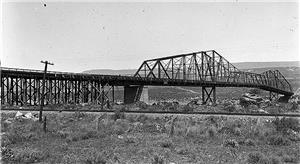On February 28, 1935, voters approve the incorporation of East Wenatchee. The measure passes by a tight margin, 48 to 46. The town's limits are small, clustered at the foot of the Columbia River Bridge, built in 1908, which connect it to the much bigger town of Wenatchee. The first mayor is Art Lenhart, who has to resign his post as county constable in order to take his new job. East Wenatchee will grow slowly for several decades but begins to take off in the 1950s. It will become a growing and prosperous suburb of Wenatchee, with an estimated population in 2010 of 11,870.
The settlement began to thrive when the bridge brought an irrigation pipeline and road traffic across the Columbia in 1908. A small business district near the bridge served a larger area of orchards and farms.
The first city officials were elected in that same February 28, 1935, incorporation vote. Art Lenhart won 52 of the 55 total votes cast for mayor. The town’s first council consists of S. H. Hamilton, Joe Huddle, Silas Hamilton (who was also the first town marshal), Sara Schuman and B. H. Crisp. A. J. Baggs was elected treasurer, with no opposition. The first judge was Ralph Ramaker.
The fledgling town had only a small budget, but it soon had help from the Works Progress Administration, which built a sewer system. The first city hall was located on what is now Valley Mall Parkway, south of 9th Street.

